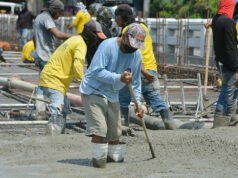March inflation below expectation, gives BSP policy space
By Melissa Luz T. Lopez, Senior Reporter
and Carmina Angelica V. Olano, Researcher
INFLATION further eased for the fifth straight month in March, the Philippine Statistics Authority (PSA) reported, lending support to the central bank’s view that price increases will ease this year even as officials signaled caution against swift plans to cut policy rates.
March’s headline rate of 3.3% — the slowest since January 2018’s 3.4% — was down from 3.8% in February and 4.3% in the same month last year. It also fell within the Bangko Sentral ng Pilipinas’ (BSP) 3.1%-3.9% forecast for March and the 3.5% median estimate in a BusinessWorld poll of analysts.
Year-to-date, inflation is at 3.8%, marking the return to the BSP’s target range for 2019. This also puts price movements on track towards the central bank’s three percent forecast for the entire year.
Core inflation, which excludes commodities prone to volatile price swings, went down to 3.5% in March from 3.9% in February.
The PSA attributed the downtrend primarily to the slower annual increase in the heavily weighted food and non-alcoholic beverage index at 3.4% in March from 4.7% in February and 5.9% in March 2018.
The PSA also noted slower annual markups in the indices of alcoholic beverages and tobacco at 10.8% in March from 12.2% in February; housing, water, electricity, gas, and other fuels at 3.4% from 3.7%; furnishing, household equipment and routine maintenance of the house at 3.4% from 3.8%; health at 3.9% from 4.2%; communication at 0.3% from 0.4%; and restaurant and miscellaneous goods and services at 3.7% from 4%.
BSP Governor Benjamin E. Diokno said the slower-than-expected 3.3% inflation rate last month is “certainly good news,” but noted that emerging risks may affect price dynamics.
Mr. Diokno flagged emerging price risks from a “stronger and prolonged” El Niño episode and the continued rise in global crude oil prices, even if the global economic slowdown and the local budget impasse could keep prices at bay.
“Against this backdrop, the BSP will continue to keep a close watch over price developments in the country and shall consider all relevant information at its next monetary policy meeting on May 9 to ensure that the monetary policy stance remains consistent with the BSP’s primary mandate of price stability,” Mr. Diokno said via text message.
The BSP chief has repeatedly said that he is seeing room to ease interest rates, although the Monetary Board voted last month to keep policy settings on hold. The policymakers said they still need to confirm if the inflation downtrend will be sustained, as they only had the data for the first two months of 2019 at the time.
In a statement, the National Economic and Development Authority said the signing of the Rice Tariffication Law has helped ease food prices, together with the end of the three-month closed fishing season in the Visayas. Malacañang also said that they are “confident” that the downward inflation path will be sustained.
Market watchers have been calling for a May 9 rate cut, saying that it will mark the first step to undo last year’s 175 basis points of rate increases.
TIME TO LOOSEN MONETARY POLICY?
Nicholas Antonio T. Mapa, senior economist at ING Bank N.V. Manila, said conditions are ripe for policy easing.
“With inflation now more firmly entrenched, inflation expectations anchored and demand-side pressures to inflation limited, we do expect the BSP to finally consider reducing reserves in the near term and slashing its policy rate at the May 9 meeting given signs of growth slowing after several institutions scaling back their growth projections for the year,” Mr. Mapa said in a statement to reporters.
For Union Bank of the Philippines, Inc. (UnionBank) chief economist Ruben Carlo O. Asuncion, a cut in the reserve requirement ratio is “more likely” in the coming months than a cut in interest rates.
“However, a 50-basis point cut this year is not being ruled out. These RRP (reverse repurchase rate) cuts may come in the second half of 2019 as inflation expectations become more anchored.”
For his part, BSP Deputy Governor Diwa C. Guinigundo said they still need to “be very careful” in setting local interest rates, in the context of a global economic slowdown.
“We need to see a clear disinflationary trend established by more observations of within target monthly inflation readings with year-to-date inflation firmly settling within the range. We also want to see inflationary expectations turning out in broad consistency with the inflation objective,” Mr. Guinigundo said in a separate text message.
“A good outlook in inflation is consistent with the effort to achieve higher output growth because that encourages both consumption expenditure and domestic capital formation,” Mr. Guinigundo added.
OUTLOOK
As for inflation, analysts were optimistic that the pace of general price increases will be kept within the BSP’s target range even as price pressures remain, particularly on food and transport.
“2019 inflation is expected to be in a downtrend as food supplies normalize and as global gasoline prices remain at current levels,” UnionBank’s Mr. Asuncion said.
However, “a higher-than-expected rise in global oil prices can definitely hamper UnionBank’s Economic Research Unit’s 2019 inflation view including food supply shocks due to weather disturbances such as the El Niño phenomenon,” he added.
For ING Bank’s Mr. Mapa: “With supply chains normalizing, the 2018 inflation pop has faded very quickly with inflation now firmly within target to help solidify expectations for within-target inflation for this year and next.”
“[A]lthough risks to the inflation outlook remain, the threat of oil price spikes and El Niño crop damage all emanate from the supply side of the equation and would be best addressed by measures on the supply side,” he said.



